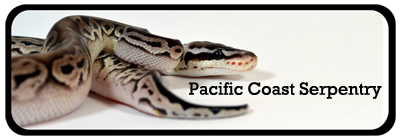» Site Navigation

0 members and 810 guests
No Members online
Most users ever online was 47,180, 07-16-2025 at 05:30 PM.
» Today's Birthdays

» Stats

Members: 75,912
Threads: 249,115
Posts: 2,572,187
Top Poster: JLC (31,651)
Welcome to our newest member, coda
|
-
The Uniquesness Of Breeding Snakes
This is just a commentary on something I noticed a while ago but I never really see anyone talk about it. Please keep in mind I am talking in generalities and they their are exceptions to the norms.
When I look at the other types of pets and variations that are sought after, it's very purebred driven. Sure lots of folks have mutts and love mutts but most are interesting in a particular breed. My mother has two Siamese cats. The only way to get a pure Siamese is to breed 2 Siamese together. Basically, people desire the "Super" or Homozygous forms of dog and cat variations. It's the pure breeds that are most popular and cost the most money.
Snake people, on the other hand, seem to be more interested in the "mutts" of the snake world. We are overjoyed when we get some multigene combo that only has a 6% chance of hatching. And, generally speaking, it's these mutigene animals that are sought after and higher priced.
So it makes me curious why the industries are so different in their preferences. I know it can't be an individual's mindset. I prefer pure breed dogs and cats over some sort of combo. But while I find some Supers are nice to look at, I find the combos more exciting.
What are you thought are the subject?
-
-
Well different breeds look different, so breeding them together gets you a mix of physical build and characteristics, not just color. You're comparing breeds vs. colors. That's very different. I know people who breed rough and smooth collies and they're always chasing after merle and other colors.
 Alluring Constrictors Alluring Constrictors
-
-
Well, I'm not sure sure I agree with you on this one. There are a lot of BP morphs, but have you seen the list of "morphs" approved by the AKC?
Affenpinscher
Afghan Hound
Airedale Terrier
Akita
Alaskan Malamute
American English Coonhound
American Eskimo Dog
American Foxhound
American Staffordshire Terrier
American Water Spaniel
Anatolian Shepherd Dog
Australian Cattle Dog
Australian Shepherd
Australian Terrier
Basenji
Basset Hound
Beagle
Bearded Collie
Beauceron
Bedlington Terrier
Belgian Malinois
Belgian Sheepdog
Belgian Tervuren
Bernese Mountain Dog
Bichon Frise
Black Russian Terrier
Black and Tan Coonhound
Bloodhound
Bluetick Coonhound
Border Collie
Border Terrier
Borzoi
Boston Terrier
Bouvier des Flandres
Boxer
Boykin Spaniel
Briard
Brittany
Brussels Griffon
Bull Terrier
Bulldog
Bullmastiff
Cairn Terrier
Canaan Dog
Cane Corso
Cardigan Welsh Corgi
Cavalier King Charles Spaniel
Cesky Terrier
Chesapeake Bay Retriever
Chihuahua
Chinese Crested
Chinese Shar-Pei
Chinook
Chow Chow
Clumber Spaniel
Cocker Spaniel
Collie
Curly-Coated Retriever
Dachshund
Dalmatian
Dandie Dinmont Terrier
Doberman Pinscher
Dogue de Bordeaux
English Cocker Spaniel
English Foxhound
English Setter
English Springer Spaniel
English Toy Spaniel
Entlebucher Mountain Dog
Field Spaniel
Finnish Lapphund
Finnish Spitz
Flat-Coated Retriever
French Bulldog
German Pinscher
German Shepherd Dog
German Shorthaired Pointer
German Wirehaired Pointer
Giant Schnauzer
Glen of Imaal Terrier
Golden Retriever
Gordon Setter
Great Dane
Great Pyrenees
Greater Swiss Mountain Dog
Greyhound
Harrier
Havanese
Ibizan Hound
Icelandic Sheepdog
Irish Red and White Setter
Irish Setter
Irish Terrier
Irish Water Spaniel
Irish Wolfhound
Italian Greyhound
Japanese Chin
Keeshond
Kerry Blue Terrier
Komondor
Kuvasz
Labrador Retriever
Lakeland Terrier
Leonberger
Lhasa Apso
Lowchen
Maltese
Manchester Terrier
Mastiff
Miniature Bull Terrier
Miniature Pinscher
Miniature Schnauzer
Neapolitan Mastiff
Newfoundland
Norfolk Terrier
Norwegian Buhund
Norwegian Elkhound
Norwegian Lundehund
Norwich Terrier
Nova Scotia Duck Tolling Retriever
Old English Sheepdog
Otterhound
Papillon
Parson Russell Terrier
Pekingese
Pembroke Welsh Corgi
Petit Basset Griffon Vendeen
Pharaoh Hound
Plott
Pointer
Polish Lowland Sheepdog
Pomeranian
Poodle
Portuguese Podengo Pequeno
Portuguese Water Dog
Pug
Puli
Pyrenean Shepherd
Rat Terrier
Redbone Coonhound
Rhodesian Ridgeback
Rottweiler
Russell Terrier
Saluki
Samoyed
Schipperke
Scottish Deerhound
Scottish Terrier
Sealyham Terrier
Shetland Sheepdog
Shiba Inu
Shih Tzu
Siberian Husky
Silky Terrier
Skye Terrier
Smooth Fox Terrier
Soft Coated Wheaten Terrier
Spinone Italiano
St. Bernard
Staffordshire Bull Terrier
Standard Schnauzer
Sussex Spaniel
Swedish Vallhund
Tibetan Mastiff
Tibetan Spaniel
Tibetan Terrier
Toy Fox Terrier
Treeing Walker Coonhound
Vizsla
Weimaraner
Welsh Springer Spaniel
Welsh Terrier
West Highland White Terrier
Whippet
Wire Fox Terrier
Wirehaired Pointing Griffon
Xoloitzcuintli
Yorkshire Terrier
-
-
I'm with Marrissa. I think a batter parallel would be to compare BP morphs to chocolate, yellow, and black Labrador retrievers. Crossing breeds is more akin to hybrids (carpalls, bateaters, etc.), which tend to be more frowned upon in the industry.
~~~~~~~~~~~~~~~~~~~~~~~~~~~~~~~~~~~~~~~~~~~~~~~~


-
-
Re: The Uniquesness Of Breeding Snakes
 Originally Posted by Annarose15

I'm with Marrissa. I think a batter parallel would be to compare BP morphs to chocolate, yellow, and black Labrador retrievers. Crossing breeds is more akin to hybrids (carpalls, bateaters, etc.), which tend to be more frowned upon in the industry.
Can't say I agree with that. All dogs are still dogs; the same species. A breed in Ball Python lingo would be a Homozygous or Super form.
The dog version of a combo morph would be a Labradoodle. It has a following but Labradors and Poodles are more popular and sought after.
-
-
Re: The Uniquesness Of Breeding Snakes
 Originally Posted by Annarose15

I'm with Marrissa. I think a batter parallel would be to compare BP morphs to chocolate, yellow, and black Labrador retrievers. Crossing breeds is more akin to hybrids (carpalls, bateaters, etc.), which tend to be more frowned upon in the industry.
I agree here to this is a great way to look at it. You can also do this with many other dogs like boxers just to name a fee there is brindle, reverse brindle, fawn, white ect...
-Brian-

-
-
Mutts are way better  Too many health issues with most purebreds. Too many health issues with most purebreds.
I agree with Mason though, Breeds = morphs a dog equivalent hybrid would be well..a Hybrid! Wolf Hybrid, Dingo Hybrid, Coyote hybrid etc
-
-
Re: The Uniquesness Of Breeding Snakes
Ummmm dogs do not come in morphs they come in breeds... Each breed has been bred for extremely long times to come to the current day standards and were all bred because of the job they were meant to do. Ball python morphs are not different breeds at all they are naturally occurring genetic mutations. A black lab looks like that because someone wanted it to. A pastel looks as it does because a gene got screwed up. Now a lemon pastel, gratazani pastel, and all those other ones would be to ball pythons what the black lab is to dogs. Each is a different "line" or breed that looks as it does due to selective breeding.
Knowledge is earned not learned.
-
-
Re: The Uniquesness Of Breeding Snakes
I disagree with the op and agree with Anna and Diamond.
I think of morphs as different colors/phenotype of one specific breed rather than many different breeds. All ball pythons are physically still the same as each other, just with a different paint job.
Like how doberman pinschers have black, white, black and tan, red and tan,.blue and tan, and fawn and tan. No matter what the color, still a purebred doberman in the end.
Sent from my DROID RAZR using Tapatalk 2
Last edited by satomi325; 08-22-2013 at 04:41 PM.
-
The Following User Says Thank You to satomi325 For This Useful Post:
-
But if you think in terms of length of breeding, original "dogs" all looked similar, they were bred for specific traits over a long long time. Some of them being genetically mutated, ie, this gene makes this pup much smaller than the other pups of this litter. I get what you are saying, but in reality we're comparing apples and oranges.
Breed small pup from this litter to small pup from that litter, get more small pups. Breed those small pups to other small pups, add in pups who have bigger chests, smaller ears, whatever...all of that is genes making them different.
If you wanted to say all bps were the same physically, what about sub Saharan? Or, different python, but dwarf retics/burms? Scaleless corns? The are all the same species, but they are physically different from one another. It's just a matter of time before someone pops out a dwarf bp and decides to work on that line of genetics. In truth, we are just scratching the surface of "breeds" for snakes. Right now we're only working on color coats, eventually, size, temperament, scales, etc will all come into play.
Edit: I get what you're saying about naturally occurring vs line breeding, but in the end it's all genes. They are mutated and shaped in one way or another. It just seems to me silly to consider all these different breeds like all the different species of snakes. A labradoodle does not a hybrid make.
Last edited by RoseyReps; 08-22-2013 at 05:03 PM.
-
 Posting Permissions
Posting Permissions
- You may not post new threads
- You may not post replies
- You may not post attachments
- You may not edit your posts
-
Forum Rules
|









 Reply With Quote
Reply With Quote




 Too many health issues with most purebreds.
Too many health issues with most purebreds.


